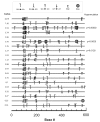APOBEC3G mRNA expression in exposed seronegative and early stage HIV infected individuals decreases with removal of exposure and with disease progression
- PMID: 19254362
- PMCID: PMC2661038
- DOI: 10.1186/1742-4690-6-23
APOBEC3G mRNA expression in exposed seronegative and early stage HIV infected individuals decreases with removal of exposure and with disease progression
Abstract
Background: APOBEC3G is an antiretroviral factor that acts by inducing G to A mutations. In this study, we examined the expression of APOBEC3G in uninfected HIV-1 exposed individuals at the time of their partner's diagnosis and one year later. We then compared this expression with that of infected individuals at different disease stages. APOBEC3G mRNA was measured in PBMCs from three groups: healthy controls with no known risk factor to HIV infection (n = 26), exposed uninfected individuals who had unprotected sex with their HIV+ partners for at least 3 months (n = 37), and HIV infected patients at various disease stages (n = 45), including 8 patients with low HIV viral loads < 10,000 copies/mL (LVL) for at least 3 years. Additionally, we obtained sequences from the env, gag, pol, nef, vif and the LTR of the patients' virus.
Results: Exposed uninfected individuals expressed higher APOBEC3G than healthy controls (3.86 vs. 1.69 relative expression units), and their expression significantly decreased after a year from the HIV diagnosis and subsequent treatment of their partners. Infected individuals showed a positive correlation (Rho = 0.57, p = 0.00006) of APOBEC3G expression with CD4+ T cell count, and a negative correlation with HIV viremia (Rho = -0.54, p = 0.00004). The percentage of G to A mutations had a positive correlation (Rho = 0.43, p = 0.0226) with APOBEC3G expression, and it was higher in LVL individuals than in the other patients (IQR 8.27 to 9.64 vs. 7.06 to 8.1, p = 0.0084). Out of 8 LVLs, 3 had hypermutations, and 4 had premature stop codons only in viral vif.
Conclusion: The results suggest that exposure to HIV may trigger APOBEC3G expression in PBMCs, in the absence of infection. Additionally, cessation of exposure or advanced disease is associated with decreased APOBEC3G expression.
Figures




References
Publication types
MeSH terms
Substances
LinkOut - more resources
Full Text Sources
Medical
Research Materials

